by California Casualty | Firefighters, News |
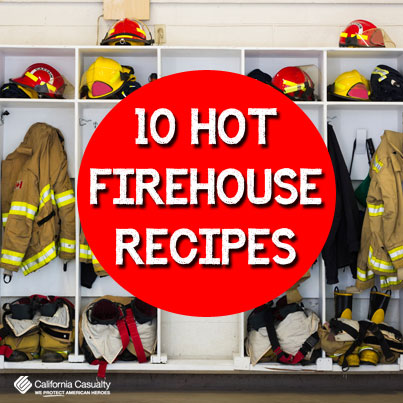
We’ve often wondered how they do it. We are talking about cooking for the crew at a fire station. Think about it; it’s hard enough preparing food for a family, but it’s even harder for a couple dozen men and women who might have to bolt at a moment’s notice. Any firehouse cook knows preparation and cooking time has to be easy, the meal nutritious, and it must be as good later that day or night as it was fresh out of the oven. We are not talking about the typical “5 Alarm Chili,” but quick, healthy meals that will nourish men and women in a physically and mentally demanding job.
While there are myriad recipe sites, we culled (we wish we could have tasted) through a half dozen to come up with these top 10 Firehouse Recipes:
- Ross Signorino’s “Rossome Ribs” (winner of Live with Regis and Kelly’s Coast to Coast Firehouse Cook-off), https://www.bhg.com/recipe/pork/rossome-ribs-firehouse-cook-off-winner/
- Runner up Tara Daniels’ “Smokin’ Pear Salad,” https://safesidesecurity.blogspot.com/2010/09/woodland-firefighter-tara-daniels.html
- Fettuccine with Ham and Chicken (submitted to thefirestations.com recipe page by Lake Jackson Volunteer Fire Department Chief Eileen Williams), https://thefirestations.com/recipe.htm
- Chief 53 Salad, also submitted to thefirestations.com recipe page by Snohomish County Fire Dist. #26’s Linda Larson, https://thefirestations.com/recipe.htm
- Mexican Lasagna from FireRecruit.com’s recipe page, https://www.firerecruit.com/kitchen/courses/810803-Mexican-Lasagna
- Firehouse Special Recipe submitted to TasteofHome.com recipe section by Darrell Alvord, https://www.tasteofhome.com/recipes/the-firehouse-special
- Firehouse Sweet Potato Hash on Yummly, https://www.yummly.com/recipe/Firehouse-Sweet-Potato-Hash-1040158?columns=6&position=1%2F8
- Italian Wedding Soup-Firehouse Style, also on Yummly, https://www.yummly.com/recipe/Italian-Wedding-Soup-Firehouse-Style-Recipezaar?columns=6&position=6%2F8
- Dan’s Smoky Vegetarian Chili submitted to Firehouse-cooking.com by Lt. Dan Chieffo of the Waterbury, CT Fire Department, https://www.firehouse-cooking.com/firehousecookingsitepages/recipearchive.html
- West Coast Jambalaya, submitted to FireRecruit.com by Capt. Mike Martinez, https://www.firerecruit.com/kitchen/courses/586887-West-Coast-Jambalaya
California Casualty understands that fire personnel work hard to protect their communities. That’s why we created the Work Hard/Play Hard contest, where one lucky first responder will win a custom Harley-Davidson FLHP Road King or $25,000. Don’t miss your chance; the entry deadline is October 7, 2015 with a winner announced later that month. The complete rules and entry form can be found at www.gocalcas.com/harley.
Auto and home insurance isn’t something that should wreck your appetite – contact a California Casualty advisor today to learn about quality insurance designed for firefighters with exclusive benefits not available to the general public. Call today for a policy review or comparison at 1.800.800.9410 or visit www.calcas.com/FireFighters.
by California Casualty | Firefighters |
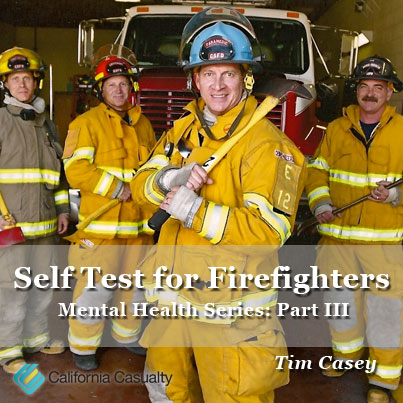 Tim Casey describes himself as, “a retired firefighter/paramedic, author, lecturer, public speaker and an alcoholic. As a public servant for more than 30 years, I know the hero business from the inside out, and I also know the costs of that profession; the human cost. My passion is trying to help save the lives of lifesavers. Firefighters are dying in record numbers, not on the job but by their own hands. Clinicians and therapists, although well intentioned, do not know how to help emergency workers and I want to help them understand us, and maybe save some lives along the way.
Tim Casey describes himself as, “a retired firefighter/paramedic, author, lecturer, public speaker and an alcoholic. As a public servant for more than 30 years, I know the hero business from the inside out, and I also know the costs of that profession; the human cost. My passion is trying to help save the lives of lifesavers. Firefighters are dying in record numbers, not on the job but by their own hands. Clinicians and therapists, although well intentioned, do not know how to help emergency workers and I want to help them understand us, and maybe save some lives along the way.
Chief Jeff Dill of the Palatine Rural Fire Protection District in suburban Chicago is a friend of mine and endless source of hope and dedication. I have lectured with him at firefighter conventions.
Because Dill is a nationally recognized authority on behavioral health issues within the fire service. He established Counseling Services for Fire Fighters, LLC based on the tragic events that surrounded Hurricane Katrina. When speaking with firefighters who returned after serving the community of New Orleans, Jeff heard the pleas of firefighters who had a difficult time talking with counselors who did not have any firefighting experience. They became frustrated and never did seek the help they needed. The Firefighter Behavioral Health Alliance (FBHA) 501(c) (3) organization was established to directly educate firefighters/ Emergency Medical Services (EMS) personnel and their families about behavioral health issues such as depression, Post Traumatic Stress Disorder (PTSD), anxiety and addictions, as well as firefighter suicides.
FBHA’s sole goal is to promote good mental health to the men and women of the fire service/EMS and their families; making a significant difference in reducing the numbers of firefighters who are turning to suicide to ease their pain. FBHA Founder Jeff Dill holds a Master’s Degree in Counseling and is a Licensed Professional Counselor in the state of Illinois.
What an amazing and passionate man. Chief Dill has spent countless hours helping fire departments all over America in dealing with firefighter suicide and comforting the families of those left behind.
Here are two dirty secrets of our storied institution, the fire service. When one of us suicides, the event is treated like an off the job incident; in my opinion it rarely is, it is a line of duty death to me, but that isn’t how we treat it.
Second, the families of these brothers and sisters, yeah women firefighters kill themselves too, are treated differently than a firefighter that dies an “honorable” death. They may get short-term support from their department, but they and the memory of their father, husband, wife, sister, or brother are quickly forgotten.
We don’t like to talk about this fact of our way of life; it’s scary to think about, so we step away quickly so we don’t have to think about it.
Chief Dill invited me to speak about my experience as a suicide survivor and firefighter. After I had shared my story with an, unfortunately, tiny audience, a Chief asked me if there was anything any of my co-workers could have done back then.
My answer was a solid yes! My crew knew I was suffering; they knew I was “off” my game; I displayed all the characteristics of someone on the brink. However, here is the thing; I know if one of them had pressed me, asked how I was doing I would have cracked.
Now I’m not putting any blame on anyone other than myself. It isn’t his or her fault I tried to kill myself. What I am saying is if we are the brave souls we fancy ourselves to be, shouldn’t we be brave enough to risk asking these questions of our co-workers and ourselves? Shouldn’t one of the lives we try to be one of our own? I know I questioned patients hard when they seemed to be a risk to themselves, hell I put hundreds on medical holds.
I refused to ask the hard questions of brothers and sisters I suspected of being in danger. It would have been impolite to ask. As I waited to speak with Chief Dill, I tried to work the crowd on his behalf, trying to stir up some interest and get a good crowd to come listen to Chief Dill. Well wasn’t I surprised? There were two major reactions, one was to be polite, take my information, and then quickly toss it in the trash. The other one shocked me.
While relaxing outside I struck up a conversation with two Chiefs from California. I offered them our handout on the warning signs of an impending suicide. They both read it, then one looked at the other and in unison, they said the name of a firefighter and both laughed a bit.
I asked them, “So you both agree you have a guy with these warning signs?” Both answered yes without hesitation. Then I asked what they planned to do about that. They sat there tongue tied with their eyes blinking. “Well, we gotta get inside we’re teaching a class. Thanks for the information.” And with that they walked away.
Ask the hard questions and you may save a brother or sister, or maybe yourself.
This self-test is from Chief Dill’s website. Below is a self-screening for suicide ideations for firefighters. Please circle either Y= Yes or N=No. When you have completed the screening, please review your score at the end.
- Are you feeling like a burden to your family, friends, or Fire Company? Y N
- Do you feel the world would be a better place without you in it? Y N
- Have you started to isolate yourself from others in the firehouse? Y N
- Have you found yourself turning to alcohol or other addictive behaviors to make yourself feel better? Y N
- Have you or someone close to you notice that your sleeping patterns have changed? Y N
- Are you thinking, “What is the use” when going to the fire house or responding on calls? Y N
- Do you find yourself thinking about or performing unnecessary risks while at a fire scene or on an emergency incident? Y N
- Have you found an increased or new interest in risky activities outside the firehouse such as sky-diving, reckless motorcycle riding or purchasing guns? Y N
- Are you displaying unexplained angry emotions or been disciplined recently for anger towards other firefighters? Officers? Or the Public within the last two months? Y N
- Have you been told “you have changed” by Friends? Family? Firefighters? Y N
- Does your family have a history of suicide? Y N
- Do you have a history of feeling depressed? Y N
- Do you have feelings of hopelessness? Y N
- Do you feel like killing yourself? Y N
- Have you created plans to kill yourself? Y N
- 16. Have you recently attempted to kill yourself? Y N
Scoring: Total the amount of (Yes) circled.
Score:__________
If you circled question 15 or 16, then please seek help immediately from a trusted friend, chaplain, counselor, dial 911 or call the National Suicide Prevention Lifeline 1-800-273-TALK (8255) or 1-800-SUICIDE (1-800-784-2433
You can listen to Jeff’s last appearance on the Firefighter Netcast Show here: “Counseling For a Firefighter- By a Firefighter” In this program, Chief Dill tells us about a new resource coming to the aid of the fire service.
by California Casualty | Firefighters |
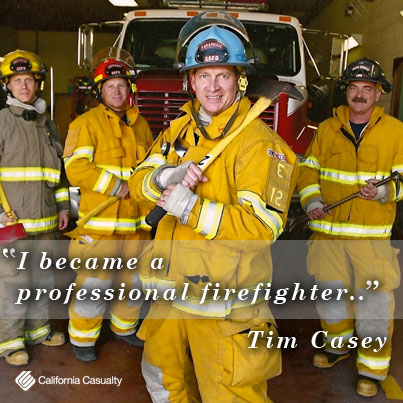
Tim Casey describes himself as, “a retired firefighter/paramedic, author, lecturer, public speaker and an alcoholic. As a public servant for more than 30 years, I know the hero business from the inside out, and I also know the costs of that profession; the human cost. My passion is trying to help save the lives of lifesavers. Firefighters are dying in record numbers, not on the job but by their own hands. Clinicians and therapists, although well intentioned, do not know how to help emergency workers and I want to help them understand us, and maybe save some lives along the way.
I became a professional firefighter/paramedic at 19 years of age and proceeded to work in that field for the next 31 years. Best job I ever had, the worst job I ever had, and it spanned four decades from 1979 until I retired in 2009. I delivered nine babies over those years, helped save hundreds of lives, and fought enough fire to keep me content into my golden years.
I became a firefighter quite by accident. Right out of high school, I went to work at the largest car dealership in my hometown. Things were going along well until the day I gave my unsolicited opinion to the general manager of the store. He admired the frankness of what I had to say but not the content of my statement.
Later that same day I called my father to tell him the news of my recent separation from work and to ask if he might be aware of any job openings. As in turned out he did know someone was hiring. The chief of a small fire department on the outskirts of town was looking for a firefighter. The next day I interviewed for the position and the day after that I was a fireman.
Looking back, I was too young, inexperienced, and naive to have made that decision; I had no idea of what was to come. I had stumbled into the coolest jobs any man could have. Overnight I went from being a zero to being a hero, an American icon, a firefighter.
I quite literally grew up in fire stations; I started as a teenager, I was married and divorced twice while I was a firefighter, I had three children, became an alcoholic, and survived a suicide attempt over those years. Throughout my entire adult life I was always part of a team and had tremendous resources available to me for all my decision-making – my fellow firefighters were more than willing to help me, especially the older guys who got a vicarious thrill out of hearing about my adventures.
The belief that we as firefighters are a brotherhood and sisterhood is deeply ingrained in our psyches from the outset of our career. No one outside our culture has any grasp on what it is to be a firefighter. People can imagine, but they can only guess how they might feel if they were confronted with the realities of our job.
However, their best guesses are based on film, TV, or literature; they are just that, a guess. If you have never walked in our boots, never walked through fire, death, and disaster, then you will never get it, you will never understand how we feel about each other.
That culture is one of the biggest problems facing the fire service, the notion that being a firefighter prevents us from being normal feeling people, from having emotions, from the damage our experiences, burden us with. It has to be abandoned, or we will suffer more and more tragedies like a result of “pulling on our big boy pants.”
We must learn to care for our own with the same vigor we extend to our customers. We must protect our people from these horrors, care for each other and our families, or we will attend more funerals and us will suffer the loss of great people because of pride, toughness, and bravado. I share my personal story of alcoholism and suicide so that when another firefighter is suffering and feeling they are alone in their struggle, they know they are not alone – that at least one other firefighter has stood in their shoes and made it out of the darkness. It’s me; I have, and I am willing to help in anyway I can.
Below are links to some valuable resources for a starting point.
4-steps-to-help-a-mentally-distressed-firefighter
Firefighter Behavioral Health Alliance
Initiative 13
by California Casualty | Firefighters, Peace Officers |
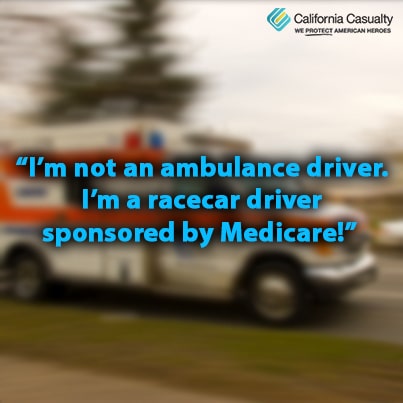
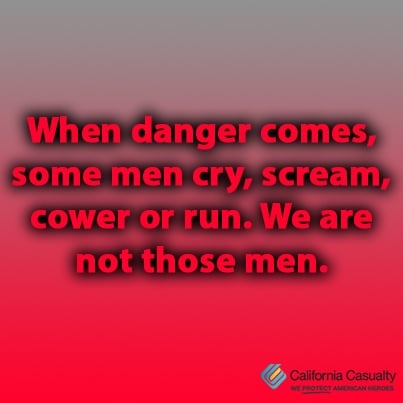
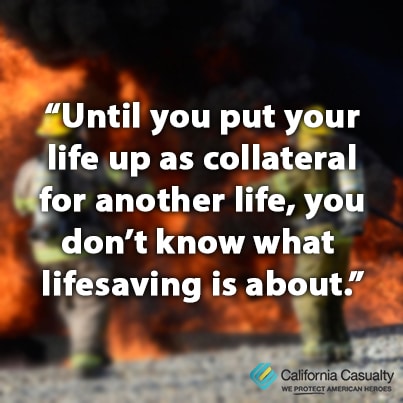
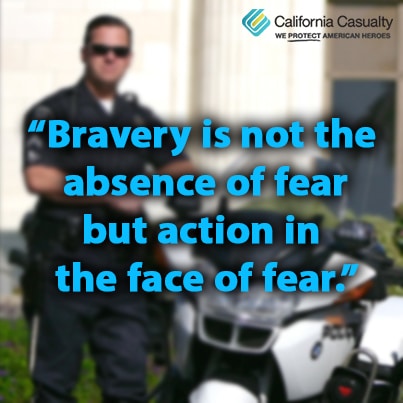
Check out these quotes for other occupations:
Educators
Nurses
by California Casualty | Firefighters |

Firefighters; they are the men and women who save property and lives. But what happens when their lives need saving? That’s the dilemma for hundreds of first-responders each year. The demands of the job and the repeated trauma they see can leave many in crisis.
Firefighters face the risk of many behavioral health concerns such as anxiety, depression, burnout and PTSD, etc. But the problem is that first responders don’t talk about behavioral health when it comes to each other. The often mentioned mantra in Fire/EMS/Law Enforcement is “We help others but never ourselves.” There is a stigma to admitting that the stress and the often disturbing scenes they respond to might be getting to them.
What makes suicide so difficult to prevent is that it is not a condition or disorder, but rather an outcome that may result from the presence (or accumulation) of many risk factors. What makes a suicide in first responders even more difficult to prevent is that they are the helpers. Who are they supposed to call for help when they are the ones who need it? Why is it so difficult for someone in Fire/EMS/Law Enforcement to ask for help? The risk of losing their peer’s respect, fear of being viewed as weak and unable to perform their jobs, fear of confidentiality, fear of losing their career? It’s no wonder, so many of the helpers suffer in silence. Many say seeking help can leave them on the fringe, considered damaged goods by their crew.
And that’s a problem; firefighter ranked number one in CareerCast’s annual survey of the most stressful jobs in 2015, just ahead of soldiers. CareerCast described the profession as, “dangerous in ever-changing conditions, with work not limited to battling blazes; firefighters also assist with medical emergencies and natural disasters.” Firefighters across the nation echo the idea of going to work each day not knowing if they will come back alive.
And that daily stress, combined with limited opportunities to talk about it, is taking a toll – as evidenced by the number 285. That’s the number of active and retired firefighters in the U.S. who are known to have taken their lives since 2012. It’s what many in the profession call “the hidden dirty little secret.” With 46 firefighters in 2015 already lost to suicide, something has to change.
It was a little- discussed topic by fire departments until Captain Jeff Dill created the Firefighter Behavioral Health Alliance (FBHA). Dill started the nonprofit after hearing about the emotional impact the World Trade Towers disaster had on firefighters in 2001, and talking with first responders about lack of mental health resources for those returning from the devastation of Hurricane Katrina in New Orleans. Captain Dill says the number of firefighter suicides that get reported is only the tip of the iceberg.
In 2004, the National Fallen Firefighters Foundation (NFFF) invited fire organization leaders to a summit on preventing line-of-duty deaths. A document titled “16 Firefighter Life Safe Initiatives” was drawn up to promote health, safety and cultural changes in the firefighting community. Number 13 calls for better access to psychological support and counseling for firefighters and their families addressing the occupational stress they face, and to counter the growing incidence of Post-Traumatic Stress Disorder cases.
Despite the effort, the problem continues. A January 2015 article in USA Today cited National Fallen Firefighters Foundation statistics that a fire department is three times more likely to experience a suicide in a given year than a line-of-duty death. They added that PTSD, depression, substance abuse and suicide were still all too common.
Slowly, more and more resources are being created to help firefighters deal with the stress of the job. The Firefighter Behavioral Health Alliance is a great first-step, with information and links to support agencies. The National Volunteer Fire Council and the National Fire Protection Association also dedicate numerous resources to linking firefighters in crisis with agencies that can help.
Some of those are:
• Emergency Ministries – providing chaplains for first-responder counseling and support,
• Rosecrance Florian Program – offering substance abuse treatment and PTSD support for firefighters and paramedics,
• NVFC Fire/EMS Helpline, 1-888-731-FIRE
• North American Firefighters Veteran Network – 24 crisis line for addiction, anxiety, stress and more,
• The Sweeney Alliance – The focus of their program First Step Hope: Not All Wounds Are Visible addresses the difficult topics that few in the first responder professions discuss or have resources for PTSD, Suicide intervention and prevention, loss and grief.
• Station House – Treatment facility exclusively for first responders, established by first responders.
• American Academy of Experts in Trauma Stress – collaborating with organizations to meet the needs of victims and survivors
by California Casualty | Firefighters |

You Know Your Dad Was a First Responder When:
- Adam 12, T.J. Hooker, CHiPs, Code Red, Emergency and Hill Street Blues were the mainstay on the family TV
- You practiced family evacuation drills as a Father’s Day ritual
- Dad displayed the implements of the trade: unloaded shotgun, ax or chainsaw, just as the date showed up to take out his daughter
- Your door bell was a siren
- Your Holiday display consisted of emergency lights
- Dad would cruise the neighborhood “just to make sure everything was alright” before he went to bed
- Everyone was equipped with a walkie-talkie
- He had 10 cans of black shoe polish to make sure his shoes looked shiny every day
- “Resuscitation Annie” was a member of the household
- Dad would never allow the birthday candles to be lit on the cake









